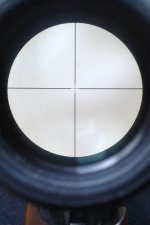Pond James Pond
New member
The first "high-end" scope I bought was my Burris XTR 312.
It was on offer and seemed to be good so I took a rather expensive punt. The Mil-dot version had been sold out by the time I had read up about them and so I got the remaining, slightly cheaper "Plex" reticle.
Now I have MOA 1/4 click turrets, but the Burris came with MRAD sleeves that you can use to replace the MOA graduated sleeves.
I had been toying with the idea of trying MRAD as a ranging method just because it seems simpler to do on the hoof. Right now I am at set ranges: 100m, 300m, but if I ever get my behind into gear and get my hunting permit, I will be in the great unknown!! There it seems that MRAD may have the edge, but here is the chink in the armour as I understand it.
Does using MRA effectively depend on some sort of graduated reticle?
In other words would my fairly featureless duplex reticle make MRAD useless?
It was on offer and seemed to be good so I took a rather expensive punt. The Mil-dot version had been sold out by the time I had read up about them and so I got the remaining, slightly cheaper "Plex" reticle.
Now I have MOA 1/4 click turrets, but the Burris came with MRAD sleeves that you can use to replace the MOA graduated sleeves.
I had been toying with the idea of trying MRAD as a ranging method just because it seems simpler to do on the hoof. Right now I am at set ranges: 100m, 300m, but if I ever get my behind into gear and get my hunting permit, I will be in the great unknown!! There it seems that MRAD may have the edge, but here is the chink in the armour as I understand it.
Does using MRA effectively depend on some sort of graduated reticle?
In other words would my fairly featureless duplex reticle make MRAD useless?


